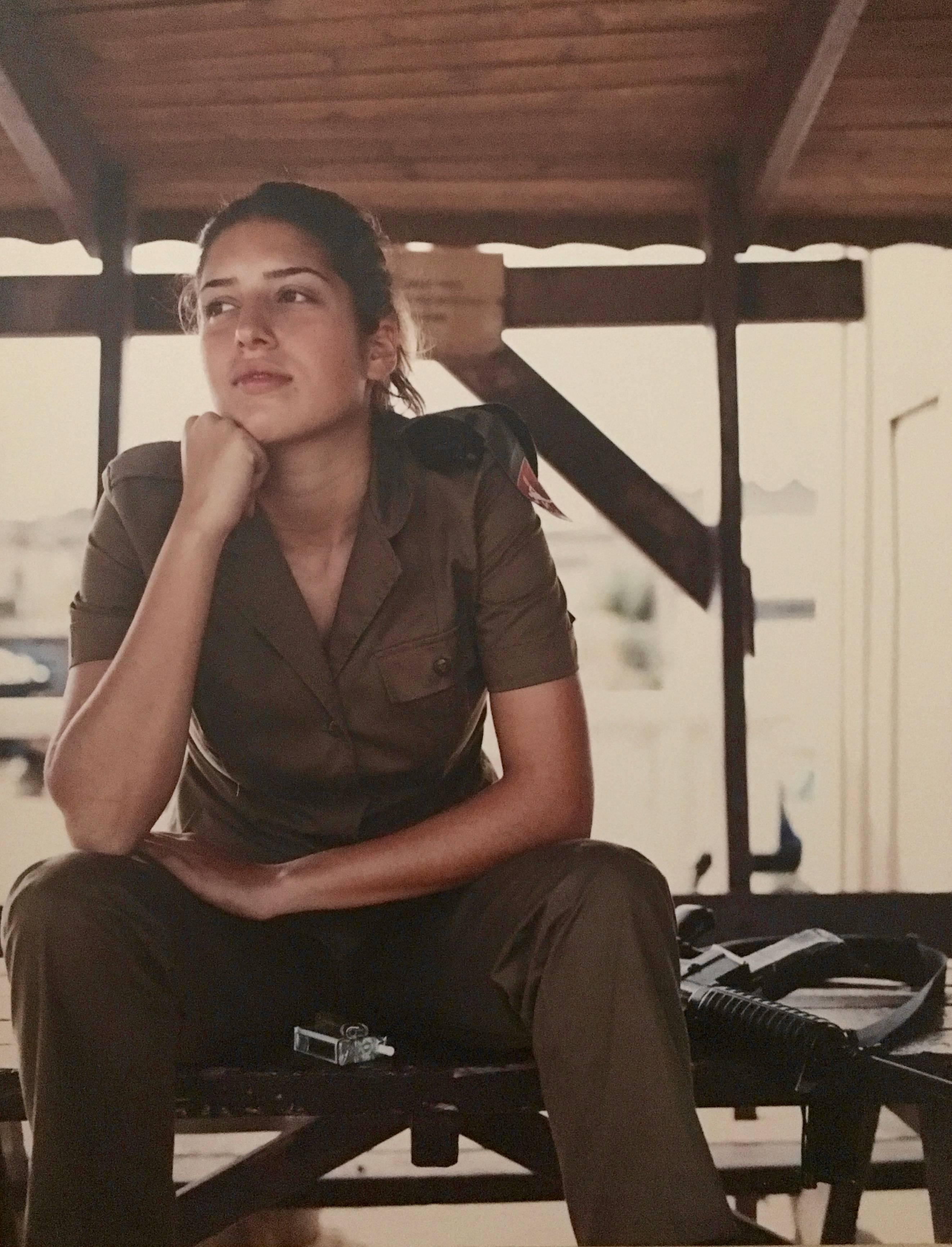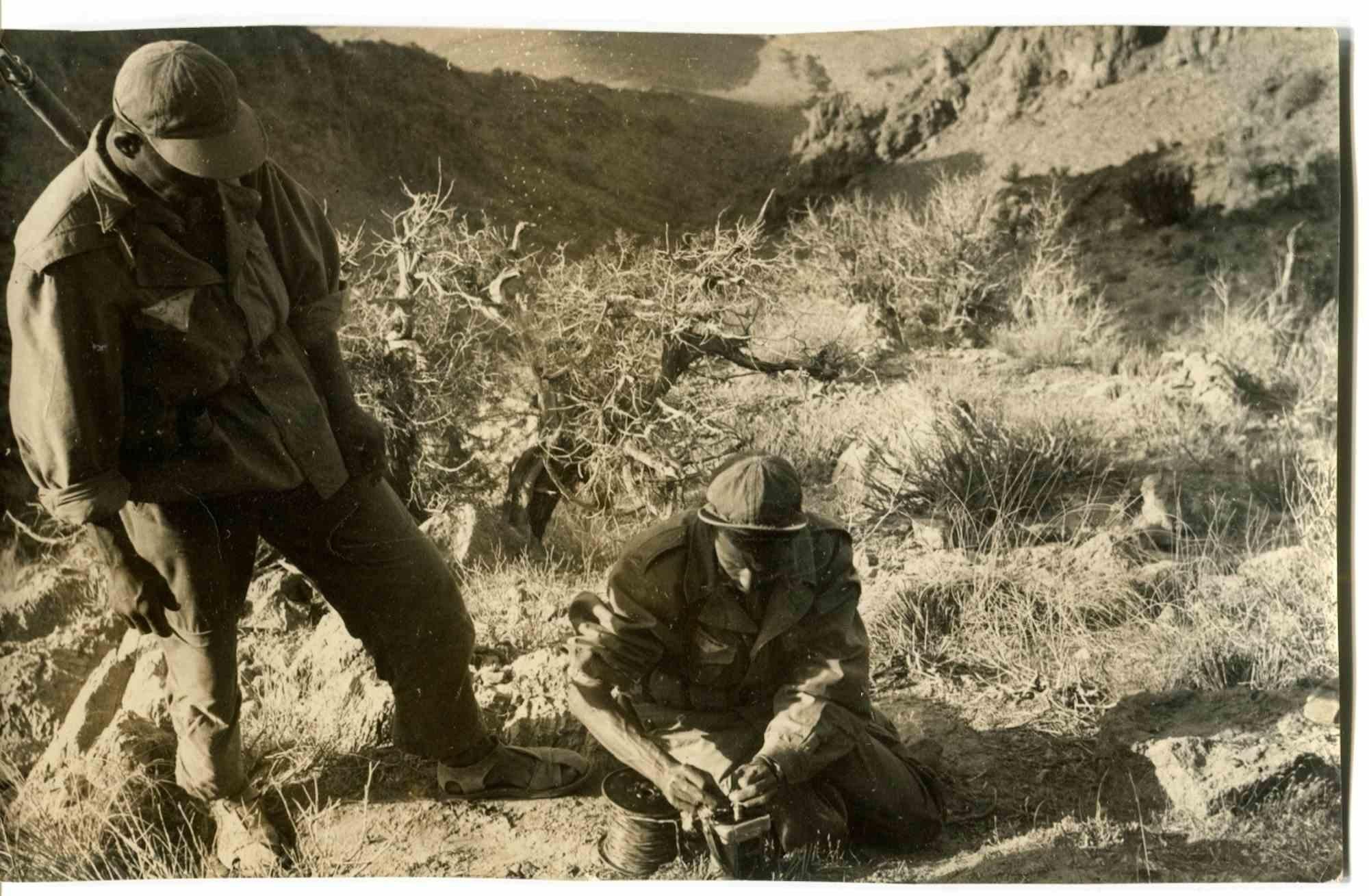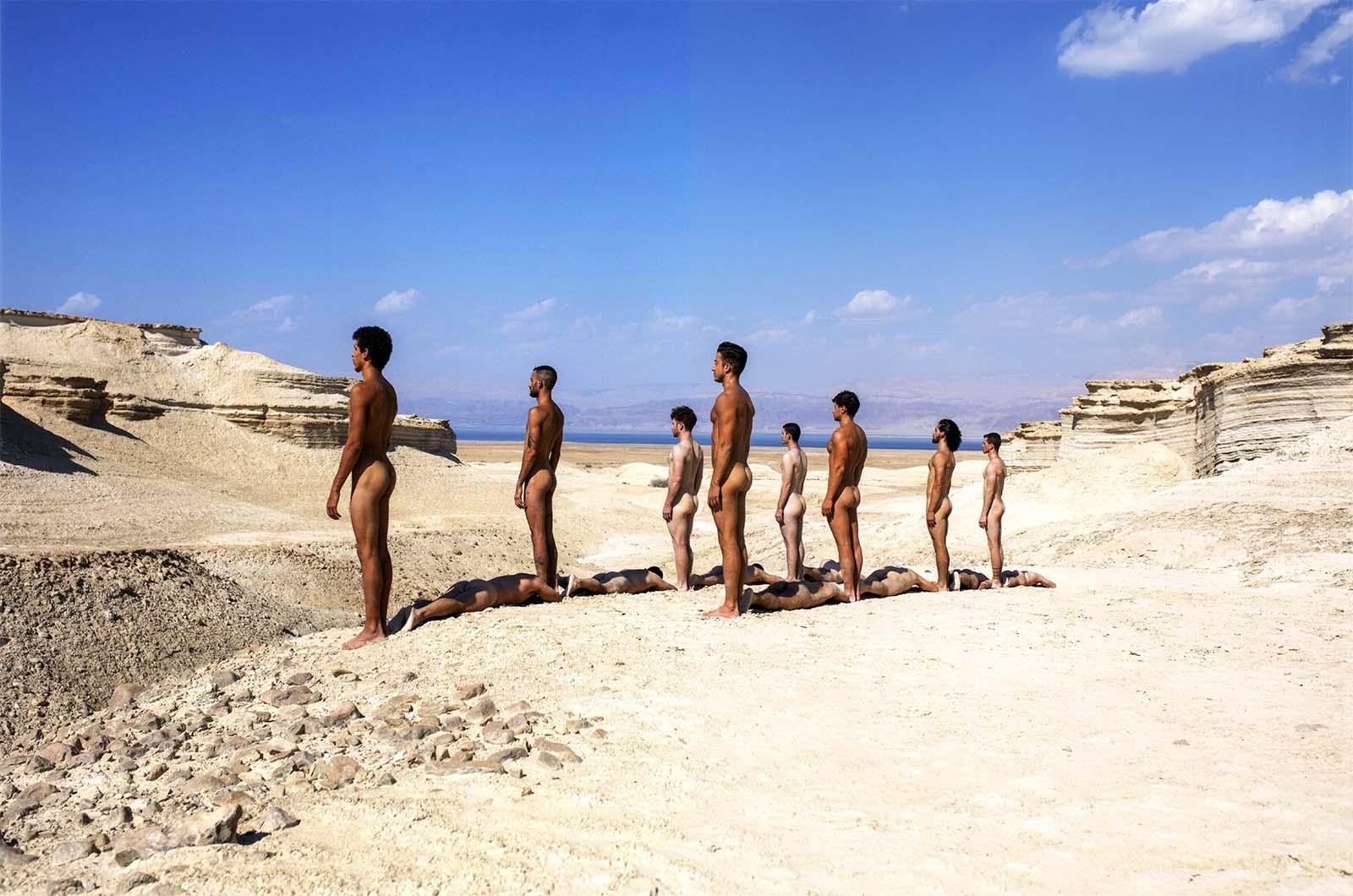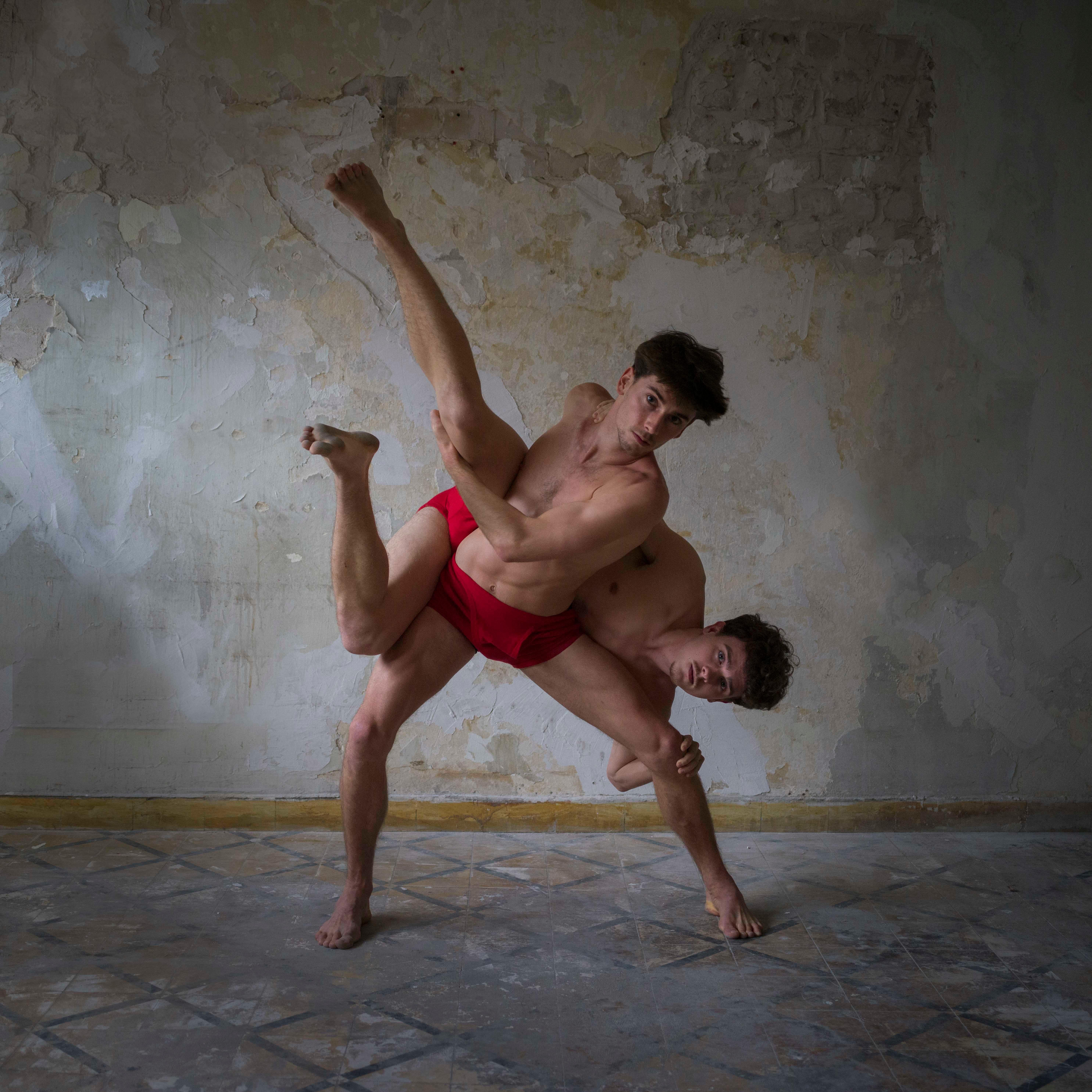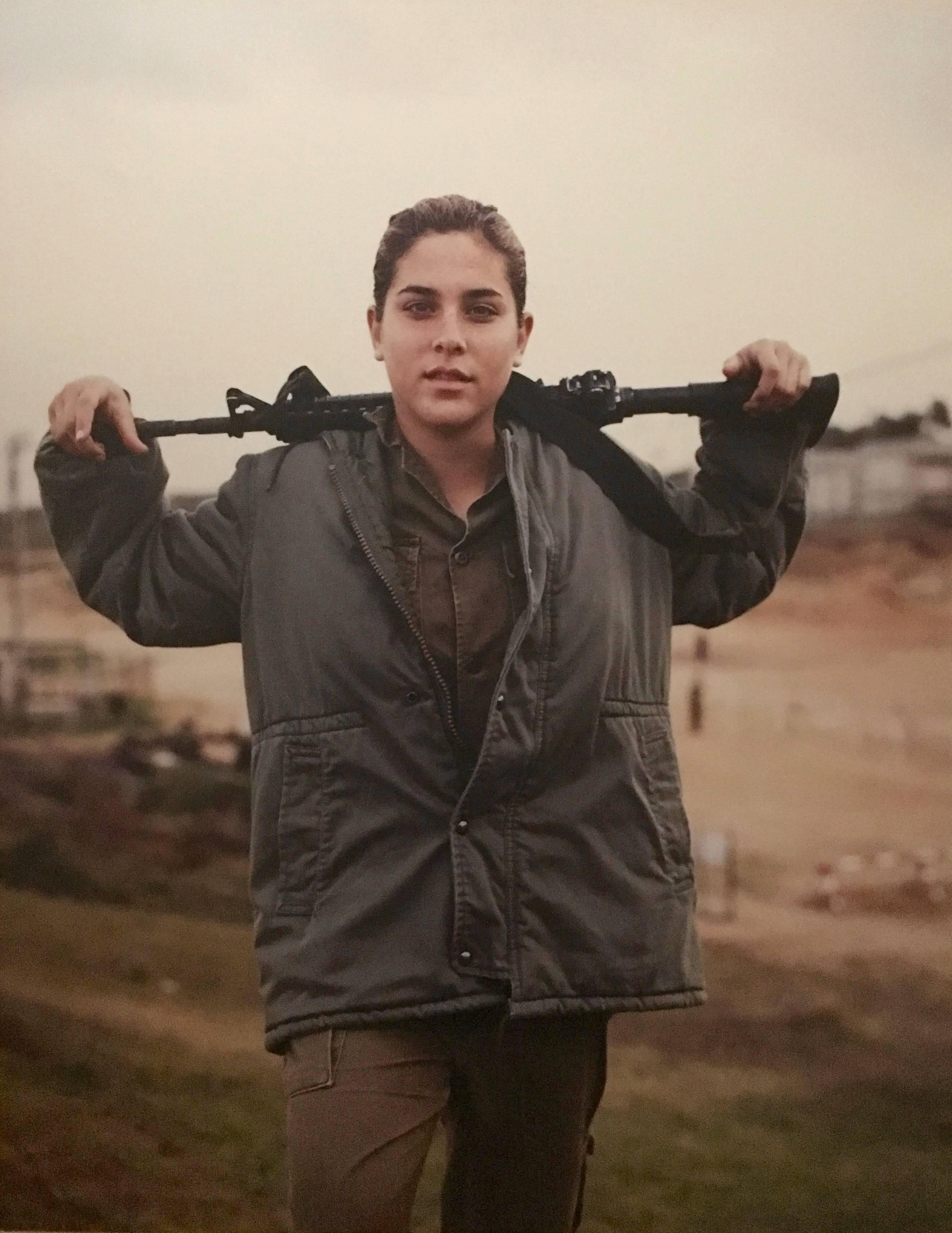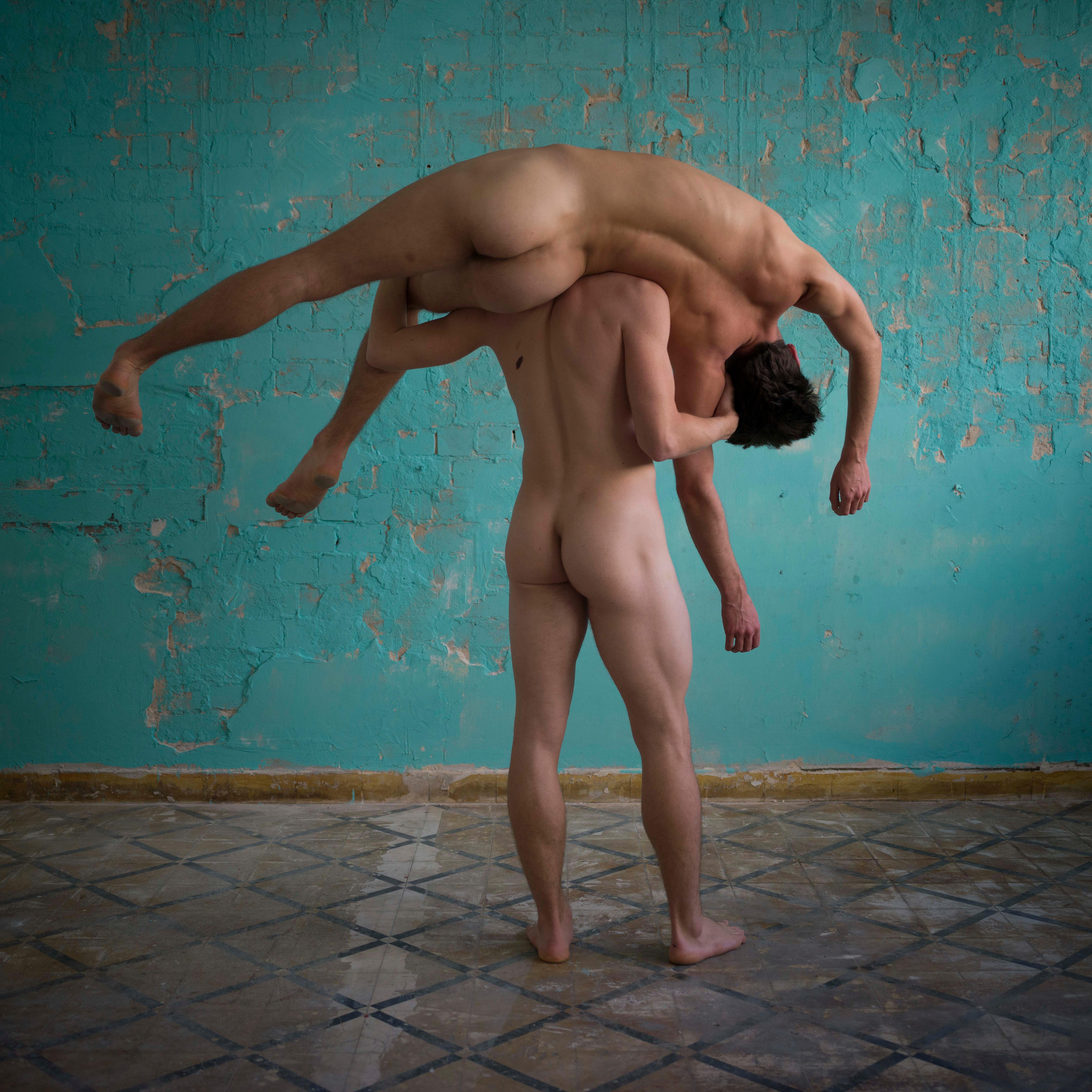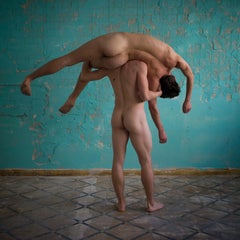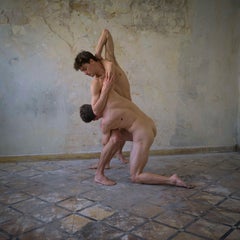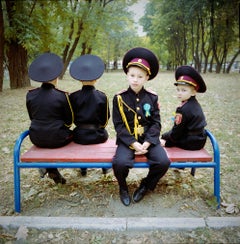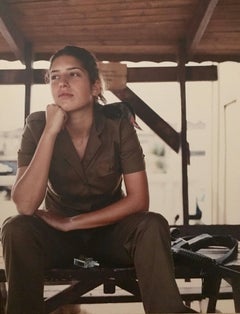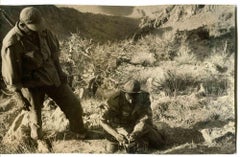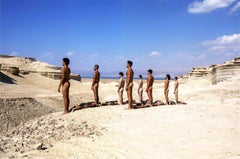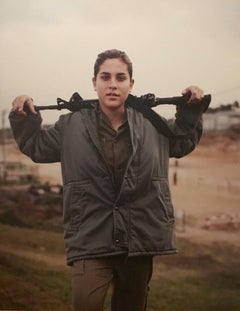Items Similar to Untitled (Soldiers No. 2)
Want more images or videos?
Request additional images or videos from the seller
1 of 5
Kobi IsraelUntitled (Soldiers No. 2)2002
2002
$4,500
£3,384.95
€3,901.72
CA$6,338.75
A$6,955.12
CHF 3,639.98
MX$85,593.93
NOK 45,858.35
SEK 42,953.17
DKK 29,133.68
About the Item
Chromogenic print
Signed and numbered, verso
(Edition of 10)
This photograph is offered by ClampArt, located in New York City.
About the artist:
Born in 1970 in a suburb of Tel-Aviv to a family of Moroccan and Egyptian origin, Kobi Israel began his exploration of photography in 1994 when he was a flight attendant. His camera always with him, he immortalized his experiences around the world, as can be seen in his early works. In his own words: “I use the camera as an extension of my body and senses, like I use my eyes or hands. When I ‘photograph’, I feel, I explore, I fantasize, I discover, I try to understand...”
In 1996, he studied cinematography at the New York Film Academy. He then returned to Tel-Aviv for a four year program in Cinematography & Still Photography at Camera Obscura, the school of visual arts in Tel-Aviv, graduating in 2001.
Israel's work has received worldwide critical acclaim and recognition from a number of prestigious publications and awards. Among others, he was granted the “Judges Choice” Award at the Association of Photographers Open Exhibition, and was selected as a finalist in the “Schweppes Photographic Portrait Prize” at the National Portrait Gallery in London.
- Creator:Kobi Israel (1970, Israeli)
- Creation Year:2002
- Dimensions:Height: 20 in (50.8 cm)Width: 30 in (76.2 cm)
- Medium:
- Movement & Style:
- Period:
- Condition:
- Gallery Location:New York, NY
- Reference Number:1stDibs: LU93232964453
About the Seller
5.0
Gold Seller
Premium sellers maintaining a 4.3+ rating and 24-hour response times
Established in 2000
1stDibs seller since 2018
268 sales on 1stDibs
Typical response time: 3 hours
- ShippingRetrieving quote...Shipping from: New York, NY
- Return Policy
Authenticity Guarantee
In the unlikely event there’s an issue with an item’s authenticity, contact us within 1 year for a full refund. DetailsMoney-Back Guarantee
If your item is not as described, is damaged in transit, or does not arrive, contact us within 7 days for a full refund. Details24-Hour Cancellation
You have a 24-hour grace period in which to reconsider your purchase, with no questions asked.Vetted Professional Sellers
Our world-class sellers must adhere to strict standards for service and quality, maintaining the integrity of our listings.Price-Match Guarantee
If you find that a seller listed the same item for a lower price elsewhere, we’ll match it.Trusted Global Delivery
Our best-in-class carrier network provides specialized shipping options worldwide, including custom delivery.More From This Seller
View AllUntitled (#8546)
By Michal Chelbin
Located in New York, NY
Michal Chelbin
Untitled (#8546)
2024
Signed and numbered, verso
Archival pigment print
37 x 37 inches
(Edition of 5 + 2 APs)
Contact gallery for price.
17 x 17 inches
(Edition of...
Category
2010s Contemporary Photography
Materials
Archival Pigment
Price Upon Request
Untitled (#9534)
By Michal Chelbin
Located in New York, NY
Michal Chelbin
Untitled (#9534)
2024
Signed and numbered, verso
Archival pigment print
37 x 37 inches
(Edition of 5 + 2 APs)
Contact gallery for price.
17 x 17 inches
(Edition of...
Category
2010s Contemporary Photography
Materials
Archival Pigment
Price Upon Request
Untitled (#9591)
By Michal Chelbin
Located in New York, NY
Michal Chelbin
Untitled (#9591)
2024
Signed and numbered, verso
Archival pigment print
37 x 37 inches
(Edition of 5 + 2 APs)
Contact gallery for price.
17 x 17 inches
(Edition of...
Category
2010s Contemporary Photography
Materials
Archival Pigment
Price Upon Request
Young Cadets (II)
By Michal Chelbin
Located in New York, NY
Signed and numbered, verso
This artwork is offered by ClampArt, located in New York City.
These images were taken in Matador Schools and Military Boarding Schools over the course o...
Category
Early 2000s Color Photography
Materials
Archival Pigment
Now What?
By Luke Smalley
Located in New York, NY
Digital C-print
Stamped and numbered, verso
20 x 24 inches
(Edition of 10)
30 x 40 inches
(Edition of 5)
50 x 60 inches
(Edition of 3)
This photograph is offered by ClampArt, loc...
Category
Early 2000s Contemporary Portrait Photography
Materials
C Print
Military kiosk counter
By Rachel Papo
Located in New York, NY
Chromogenic print
Signed, dated, and numbered, verso
20 x 24 inches
(Edition of 9)
30 x 40 inches
(Edition of 5)
This photograph is offered by ClampArt, located in New York City.
Please note that prices increase as editions sell.
At the age of eighteen, Israeli girls enter a two-year period in which they will be transformed from girls to women under the Israeli Defense Forces...
Category
Early 2000s Contemporary Portrait Photography
Materials
C Print
Price Upon Request
You May Also Like
Large Color Photograph "Women of the IDF" Ashkan Sahihi
By Ashkan Sahihi
Located in Surfside, FL
"Women of the IDF" Large Exhibition color Photograph
30 x 40 inches, mounted on masonite and laminated.
Edition of 4 + 2 artists proof. minor dings and bumps to edges Born in Tehran, Iran, Ashkan Sahihi moved with his family to West Germany at the age of seven. Although he began taking photographs as a teenager, Sahihi traces the beginning of his professional trajectory to New York in 1987, a thriving “pop culture metropolis” where he could do the kind of photography work that he wanted to do, exploring the underbelly of the society around him. Taking assignments from German publications such as the Süddeutsche Zeitung Magazine, Der Spiegel, Dummy and GEO, he photographed subjects like prisoners on death row, players in the hip-hop scene, and the downtown art scene of New York. Neither black nor white, an insider among outsiders, he found himself able to navigate spaces and dynamics that others might have had difficulty entering. He considered this both a privilege and an obligation – to visit these places and tell these stories. His success led to commissions from American publications as well, including the New York Times Magazine, the New Yorker, Rolling Stone, and Vogue.
Put off by the limitations of photojournalism (the expectation that he would illustrate the writer’s perspective rather than author a narrative of his own), Sahihi began to embark on independent, highly compact conceptual series. His main goal in these series has been to drive forward public discourse on topics he believes have not provoked enough or the right kind of discussion: drugs, gender in the media, women in the military, etc. His portraits draw on a familiar visual language – often seated subjects before a neutral backdrop – but push the viewer to feel and think about entirely new things. Although he constantly challenges the comfort level of both the viewer and the subject, Sahihi never removes himself from the line of fire; all of his work requires the artist to immerse himself in uncomfortable situations and challenge his own emotional fortitude.
Photographic Series
In the “Face Series”, latex-gloved hands manipulate the subjects’ features, stretching, pushing, squeezing, pinching at the whim of external direction – from the artist? The customer? The public? The “Hypnosis Series” comprises 8 portraits of hypnotized subjects each experiencing a single emotion, e.g. helplessness, withholding/anger, or regret. In a society that rewards the suppression of such naked emotion, the purity of these depictions is arresting.
In 2006, Sahihi photographed himself in the homes and with the families of six ex-girlfriends and one ex-wife, imposing himself more or less awkwardly on the constellations that emerged after he had exited their lives (“Exes Series”).
For Sahihi’s most well-known work, the “Drug Series,” he convinced 11 non–drug users to consume a particular drug, then took their portraits over the course of their trips. The series was born out of Sahihi’s frustration with the hypocrisy of the political conversation about drugs in the United States. “By attempting to present an objective image of drug use, the artist addresses the cultural politics that allow our society to simultaneously glamorize the ‘drug look’ in fashion magazines and the entertainment industry and meanwhile turn a blind eye to the complicated, and vast, problem of drug abuse.” Sahihi has exhibited this series at MoMA PS1 New York in 2001, in Dresden in 2008, and alongside his installation “100 Million in Ready Cash."
Sahihi’s dense explorations through small photographic series include “Women of the IDF," portraits of female Israeli soldiers...
Category
Early 2000s Portrait Photography
Materials
Laminate, Masonite
Soldiers - Mid-20th Century
Located in Roma, IT
Soldiers is an vintage photograph realized in the mid-20th Century.
Good conditions.
Category
Mid-20th Century Contemporary Black and White Photography
Materials
Photographic Paper
Bon Fire Night (Body Terrain) - In Celebration of Pride Month
Located in New Orleans, LA
Stone and Press Gallery is excited to offer several works in celebration of the LGBTQ community.
This is number 1 from a limited edition of 12.
London-based Photographer and Graphic designer Omer Ga'ash, graduated from Bezalel Academy...
Category
2010s Surrealist Color Photography
Materials
C Print
$321 Sale Price
28% Off
WOMEN OF THE IDF Large color Photograph LITAL
By Ashkan Sahihi
Located in Surfside, FL
"Women of the IDF" Large Exhibition color Photograph
30 x 40 inches, mounted on masonite and laminated.
Edition of 4 + 2 artists proof. minor dings and bumps to edges Born in Tehran, Iran, Ashkan Sahihi moved with his family to West Germany at the age of seven. Although he began taking photographs as a teenager, Sahihi traces the beginning of his professional trajectory to New York in 1987, a thriving “pop culture metropolis” where he could do the kind of photography work that he wanted to do, exploring the underbelly of the society around him. Taking assignments from German publications such as the Süddeutsche Zeitung Magazine, Der Spiegel, Dummy and GEO, he photographed subjects like prisoners on death row, players in the hip-hop scene, and the downtown art scene of New York. Neither black nor white, an insider among outsiders, he found himself able to navigate spaces and dynamics that others might have had difficulty entering. He considered this both a privilege and an obligation – to visit these places and tell these stories. His success led to commissions from American publications as well, including the New York Times Magazine, the New Yorker, Rolling Stone, and Vogue.
Put off by the limitations of photojournalism (the expectation that he would illustrate the writer’s perspective rather than author a narrative of his own), Sahihi began to embark on independent, highly compact conceptual series. His main goal in these series has been to drive forward public discourse on topics he believes have not provoked enough or the right kind of discussion: drugs, gender in the media, women in the military, etc. His portraits draw on a familiar visual language – often seated subjects before a neutral backdrop – but push the viewer to feel and think about entirely new things. Although he constantly challenges the comfort level of both the viewer and the subject, Sahihi never removes himself from the line of fire; all of his work requires the artist to immerse himself in uncomfortable situations and challenge his own emotional fortitude.
Photographic Series
In the “Face Series”, latex-gloved hands manipulate the subjects’ features, stretching, pushing, squeezing, pinching at the whim of external direction – from the artist? The customer? The public? The “Hypnosis Series” comprises 8 portraits of hypnotized subjects each experiencing a single emotion, e.g. helplessness, withholding/anger, or regret. In a society that rewards the suppression of such naked emotion, the purity of these depictions is arresting.
In 2006, Sahihi photographed himself in the homes and with the families of six ex-girlfriends and one ex-wife, imposing himself more or less awkwardly on the constellations that emerged after he had exited their lives (“Exes Series”).
For Sahihi’s most well-known work, the “Drug Series,” he convinced 11 non–drug users to consume a particular drug, then took their portraits over the course of their trips. The series was born out of Sahihi’s frustration with the hypocrisy of the political conversation about drugs in the United States. “By attempting to present an objective image of drug use, the artist addresses the cultural politics that allow our society to simultaneously glamorize the ‘drug look’ in fashion magazines and the entertainment industry and meanwhile turn a blind eye to the complicated, and vast, problem of drug abuse.” Sahihi has exhibited this series at MoMA PS1 New York in 2001, in Dresden in 2008, and alongside his installation “100 Million in Ready Cash."
Sahihi’s dense explorations through small photographic series include “Women of the IDF," portraits of female Israeli soldiers...
Category
Early 2000s Portrait Photography
Materials
Masonite
Warriors. From Searching a Mother Series. Photomontage
By Celso José Castro Daza
Located in Miami Beach, FL
Castro’s labor-intensive, photo-collage works of drug kingpins, smugglers, hitmen, countrymen, street vendors, soldiers, paramilitaries, kidnappers, and pimps pose showing with pride...
Category
Early 2000s Contemporary Color Photography
Materials
Photographic Paper, Archival Paper, Color
WOMEN OF THE ISRAEL DEFENSE FORCES Large Photo NETA
By Ashkan Sahihi
Located in Surfside, FL
"Women of the IDF" Large Exhibition color Photograph
30 x 40 inches, mounted on masonite and laminated.
Edition of 4 + 2 artists proof. minor dings and bumps to edges Born in Tehran, Iran, Ashkan Sahihi moved with his family to West Germany at the age of seven. Although he began taking photographs as a teenager, Sahihi traces the beginning of his professional trajectory to New York in 1987, a thriving “pop culture metropolis” where he could do the kind of photography work that he wanted to do, exploring the underbelly of the society around him. Taking assignments from German publications such as the Süddeutsche Zeitung Magazine, Der Spiegel, Dummy and GEO, he photographed subjects like prisoners on death row, players in the hip-hop scene, and the downtown art scene of New York. Neither black nor white, an insider among outsiders, he found himself able to navigate spaces and dynamics that others might have had difficulty entering. He considered this both a privilege and an obligation – to visit these places and tell these stories. His success led to commissions from American publications as well, including the New York Times Magazine, the New Yorker, Rolling Stone, and Vogue.
Put off by the limitations of photojournalism (the expectation that he would illustrate the writer’s perspective rather than author a narrative of his own), Sahihi began to embark on independent, highly compact conceptual series. His main goal in these series has been to drive forward public discourse on topics he believes have not provoked enough or the right kind of discussion: drugs, gender in the media, women in the military, etc. His portraits draw on a familiar visual language – often seated subjects before a neutral backdrop – but push the viewer to feel and think about entirely new things. Although he constantly challenges the comfort level of both the viewer and the subject, Sahihi never removes himself from the line of fire; all of his work requires the artist to immerse himself in uncomfortable situations and challenge his own emotional fortitude.
Photographic Series
In the “Face Series”, latex-gloved hands manipulate the subjects’ features, stretching, pushing, squeezing, pinching at the whim of external direction – from the artist? The customer? The public? The “Hypnosis Series” comprises 8 portraits of hypnotized subjects each experiencing a single emotion, e.g. helplessness, withholding/anger, or regret. In a society that rewards the suppression of such naked emotion, the purity of these depictions is arresting.
In 2006, Sahihi photographed himself in the homes and with the families of six ex-girlfriends and one ex-wife, imposing himself more or less awkwardly on the constellations that emerged after he had exited their lives (“Exes Series”).
For Sahihi’s most well-known work, the “Drug Series,” he convinced 11 non–drug users to consume a particular drug, then took their portraits over the course of their trips. The series was born out of Sahihi’s frustration with the hypocrisy of the political conversation about drugs in the United States. “By attempting to present an objective image of drug use, the artist addresses the cultural politics that allow our society to simultaneously glamorize the ‘drug look’ in fashion magazines and the entertainment industry and meanwhile turn a blind eye to the complicated, and vast, problem of drug abuse.” Sahihi has exhibited this series at MoMA PS1 New York in 2001, in Dresden in 2008, and alongside his installation “100 Million in Ready Cash."
Sahihi’s dense explorations through small photographic series include “Women of the IDF," portraits of female Israeli soldiers...
Category
Early 2000s Portrait Photography
Materials
Masonite
More Ways To Browse
Misty Copeland
Norman Seeff Joni Mitchell
Olivia De Havilland
Paul Mpagi Sepuya
Princess Diana Print
Warhol Reagan
1973 Vintage Champagne
Andre 3000
Andy Warhol Drag
Andy Warhol Farrah
Andy Warhol Funeral
Andy Warhol Jed Johnson
Andy Warhol Jed
Antonio Lopez Tina Chow
Batman Photo
Beach Photography 1970s
Bee Gees
Biggie Smalls
